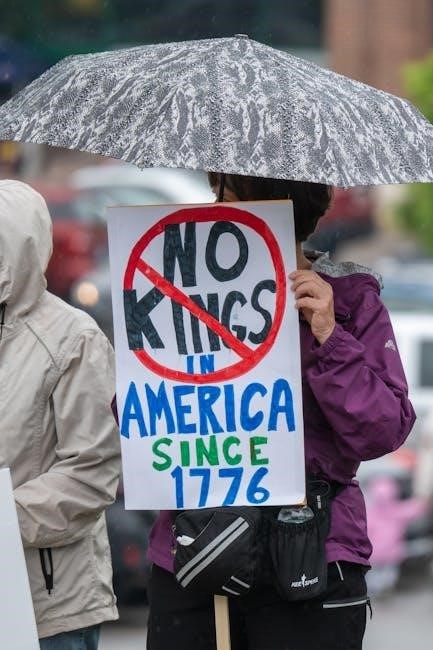Key Concepts of American Government

American government is rooted in representative government, limited government, and republicanism, shaping the colonies’ political structure and influencing the creation of a balanced, democratic system.
1.1 Representative Government
Representative government is a cornerstone of American governance, where citizens elect officials to represent their interests. This concept emerged from colonial experiences, influenced by English traditions like the Magna Carta, which limited royal power and established the principle of consent. Colonists adopted this idea, creating elected legislatures to make decisions on their behalf. For instance, the Mayflower Compact (1620) and the House of Representatives exemplify early forms of representative governance. This system ensures accountability, as elected officials are responsible to the people, preventing autocratic rule. It balances direct democracy by allowing informed decision-making while maintaining citizen involvement. The concept remains central to modern American democracy, ensuring voices are heard through elected representatives.
- Influenced by English documents like the Magna Carta.
- Colonial legislatures, such as the Virginia House of Burgesses, adopted this model.
- Elected officials act on behalf of the people, ensuring accountability.
1.2 Limited Government
Limited government is a fundamental principle of American governance, emphasizing that governmental power should not be absolute. This concept stems from colonial experiences and landmark documents like the Magna Carta, which restricted royal authority. The English Bill of Rights further reinforced the idea by limiting the monarch’s power and protecting individual liberties. In the American colonies, this principle evolved into the belief that government should operate within defined boundaries, ensuring it does not overstep its authority; The colonies adopted this idea, creating systems where power was divided and checked, preventing any single entity from becoming tyrannical. This principle laid the groundwork for the U.S. Constitution and Bill of Rights, which enshrined protections for individual freedoms and established a framework for accountable governance.
- Inspired by the Magna Carta and English Bill of Rights.
- Colonists sought to prevent abuses of power.
- Embedded in the U.S. Constitution and Bill of Rights.
1.3 Republicanism
Republicanism is a political ideology emphasizing that the government derives its authority from the people and operates in their interest. It contrasts with monarchies or aristocracies, where power resides in a select few. This concept, influenced by Enlightenment thinkers like Montesquieu, shaped the Founding Fathers’ vision of a government where elected representatives act on behalf of citizens. Republicanism stresses civic virtue, the rule of law, and the protection of individual rights while promoting the common good. The U.S. Constitution reflects republican principles through its system of representation, checks and balances, and the separation of powers, ensuring accountability and preventing the concentration of power. This philosophy remains central to American governance.
- Inspired by Enlightenment ideas of representation and accountability.
- Rejects monarchy and aristocracy in favor of popular sovereignty.
- Emphasizes civic duty and the rule of law.

Landmark English Documents
The Magna Carta, English Bill of Rights, and Mayflower Compact laid the groundwork for American government principles by establishing rights, limiting power, and promoting self-governance.
- Magna Carta
- English Bill of Rights
- Mayflower Compact
2.1 The Magna Carta
The Magna Carta, signed in 1215 by King John of England, is a cornerstone of constitutional law. It established the principle that the monarch was not above the law and protected the rights of nobles and commoners alike. Key provisions included due process, protection from unlawful imprisonment, and limits on the king’s power to raise taxes without consent. This document laid the foundation for the rule of law and influenced the development of constitutional government in America. Its emphasis on limiting authority and safeguarding individual rights shaped colonial ideals and later the U.S. Constitution.
- Established due process and the rule of law.
- Protected rights of individuals from arbitrary power.
- Inspired American colonial resistance and governance.
2.2 The English Bill of Rights
The English Bill of Rights, enacted in 1689, further established constitutional monarchy principles, limiting the monarch’s power and safeguarding individual liberties. It prohibited the suspension of laws without Parliament’s consent, ensured freedom of speech in Parliament, and protected citizens from excessive bail and cruel punishments. This document reinforced the idea of representative government and the rule of law, directly influencing American colonial ideals. Its emphasis on protecting individual rights and limiting governmental authority laid a foundation for the U.S. Constitution and Bill of Rights, shaping the colonies’ resistance to tyranny and their eventual governance structure.
- Protected rights of individuals from abuse of power.
- Ensured parliamentary authority over the monarchy.
- Influenced American colonists’ demands for liberty.
2.3 The Mayflower Compact
The Mayflower Compact, signed in 1620, was a pivotal agreement among the Pilgrims establishing a framework for self-governance in Plymouth Colony. This document, often regarded as one of America’s first political covenants, outlined the colonists’ commitment to creating a civil government based on mutual consent and the common good. It ensured that power would reside with the people rather than a single leader, laying the groundwork for democratic principles. The Compact also demonstrated the importance of cooperation and unity among the settlers, as they sought to establish a successful colony in the New World. Its legacy endures as a foundational element in the development of American government and the concept of self-rule.
- Established self-governance in Plymouth Colony.
- Emphasized consent of the governed and democratic ideals.
- Served as a model for future colonial and American governance.

Types of Colonies
Colonies were established as charter, proprietary, or royal, each with distinct governance structures shaped by their founding charters or royal authority, influencing early American governance.
3.1 Charter Colonies
Charter colonies were established by groups or individuals granted charters by the British Crown, allowing them self-governance under the king’s authority. These colonies, such as Massachusetts, had elected legislatures like the General Court, giving settlers significant political power. The charters often reflected the religious or economic goals of the founders, such as the Massachusetts Bay Colony’s focus on religious freedom. This form of governance laid the groundwork for democratic practices, as colonists became accustomed to representation and decision-making. The autonomy provided by charters fostered a sense of independence, which later influenced the movement for American independence.
3.2 Proprietary Colonies
Proprietary colonies were owned by individuals or families granted land by the British Crown, giving them control over governance. These colonies, such as Maryland and Pennsylvania, were often established for profit or religious refuge. Proprietors held significant authority, appointing governors and making laws. While this system allowed for flexibility and innovation, it sometimes led to conflicts between proprietors and settlers over land rights and political representation; The proprietary model influenced early American governance by experimenting with diverse political structures, which later shaped the nation’s approach to self-rule and individual rights.
3.3 Royal Colonies
Royal colonies were directly governed by the British monarch, with authority vested in a royal governor and council appointed by the king. This system allowed the Crown to maintain tight control over laws, policies, and land distribution. Examples include Virginia and Massachusetts after their charters were revoked. Royal governance ensured uniformity in administration but often led to tensions with local leaders, who sought greater autonomy. Over time, the centralized authority of royal colonies influenced the development of a strong federal system in the United States. The experience under royal rule also shaped colonial attitudes toward self-governance and representation, contributing to the eventual push for independence.

Philosophical Influences
The ideas of John Locke, Montesquieu, and Jean-Jacques Rousseau profoundly shaped American government, emphasizing natural rights, separation of powers, and the social contract, inspiring democratic principles.
4.1 John Locke’s Ideas
John Locke’s philosophy significantly influenced the origins of American government. His ideas about natural rights, including life, liberty, and property, were central to the Declaration of Independence. Locke argued that government derives its authority from the consent of the governed and that individuals have the right to revolt against tyranny. These principles shaped the Founding Fathers’ belief in limited government and individual freedoms. Locke’s emphasis on the social contract and the protection of inherent rights laid the foundation for democratic governance in the United States, ensuring that power remains with the people and is exercised for their collective benefit.
4.2 Montesquieu’s Contributions
Montesquieu’s ideas about the separation of powers deeply influenced the American government’s structure. In his work The Spirit of the Laws, he proposed dividing government into executive, legislative, and judicial branches to prevent abuse of power. This concept of checks and balances was adopted by the Founding Fathers to ensure no single branch could dominate. Montesquieu’s emphasis on preventing tyranny and protecting individual liberties aligned with the colonists’ desire for self-governance. His theories shaped the U.S. Constitution, particularly in the system of shared powers between branches, ensuring accountability and safeguarding against authoritarian rule. This framework remains a cornerstone of American democracy, reflecting Montesquieu’s enduring impact on its foundational principles.
4.3 Jean-Jacques Rousseau’s Impact
Jean-Jacques Rousseau’s philosophical ideas significantly influenced the origins of American government, particularly through his concept of the social contract. In his work The Social Contract, Rousseau argued that governments derive their authority from the consent of the governed, emphasizing popular sovereignty. This idea resonated with American colonists, who sought to establish a government based on the will of the people rather than monarchical rule. Rousseau’s emphasis on collective sovereignty and the general will inspired principles of democracy and self-governance, shaping the foundation of the U.S. political system. His theories also influenced the Declaration of Independence and the Constitution, reinforcing the notion that government exists to protect the rights and interests of its citizens, ensuring their voice in governance and accountability from leaders.

The Constitutional Convention
The Constitutional Convention of 1787 aimed to revise the Articles of Confederation but instead drafted the U.S. Constitution, establishing a stronger federal government with checks and balances.
5.1 Virginia Plan
The Virginia Plan, proposed by James Madison, advocated for a strong central government with three branches and representation based on population, influencing the Constitutional Convention’s framework for the U.S. government;
5.2 New Jersey Plan
The New Jersey Plan, introduced during the Constitutional Convention, proposed equal representation for all states in Congress, aiming to ensure smaller states had a voice in the federal government, balancing larger states’ influence and leading to the Connecticut Compromise.
5.3 Connecticut Compromise
The Connecticut Compromise resolved the debate over representation by creating a bicameral legislature, with the House of Representatives based on population and the Senate granting equal representation to all states, ensuring both large and small states had a fair voice in governance.
5.4 The 3/5 Compromise
The 3/5 Compromise was a significant agreement reached during the Constitutional Convention of 1787, addressing the contentious issue of enslaved individuals’ representation in Congress. Southern states, reliant on agriculture and slavery, sought to count enslaved people toward their population to gain more representation in the House of Representatives. Northern states opposed this, fearing it would unfairly enhance Southern political power. The compromise stipulated that each enslaved person would be counted as three-fifths of a person for both taxation and representation purposes. This agreement allowed Southern states to maintain influence while preventing them from dominating Congress outright. Though it temporarily resolved the issue, it perpetuated the institution of slavery and its profound impact on the nation’s political and social fabric.

The Constitution
The Constitution is the foundation of the U.S. government, establishing its framework, powers, and principles while ensuring the protection of individual rights and promoting national unity.
6.1 Preamble
The Preamble to the U.S. Constitution serves as the introductory statement, outlining the document’s purpose and objectives. It establishes the framework for the federal government, emphasizing the importance of unity, justice, and liberty. The Preamble sets forth six key goals: establishing justice, ensuring domestic tranquility, providing for the common defense, promoting general welfare, securing the blessings of liberty for oneself and posterity, and creating a more perfect union. These principles guide the interpretation and implementation of the Constitution, reflecting the Founders’ vision for a balanced and equitable government. The Preamble is not legally binding but holds significant symbolic and foundational value, shaping the nation’s identity and aspirations.
6.2 Articles of the Constitution
The U.S. Constitution is divided into seven Articles, each addressing specific aspects of the federal government’s structure and function. Article I establishes the legislative branch, granting Congress the power to make laws. Article II defines the executive branch, led by the President, while Article III outlines the judicial branch, headed by the Supreme Court. Articles IV-VI cover state relations, the amendment process, and national supremacy, respectively. Article VII details the ratification process. These Articles collectively establish the framework for a federal system with separated powers, checks and balances, and clear responsibilities for each branch. They ensure accountability and prevent the concentration of power, forming the foundation of the U.S. government’s operational structure.
6.3 Ratification Process
The ratification process of the U.S. Constitution involved state-by-state approval through special conventions. Each state held debates, with Federalists supporting the Constitution and Anti-Federalists expressing concerns about individual liberties and federal power. Key figures like James Madison played crucial roles in addressing objections. The process required nine of the thirteen states to approve it for the Constitution to take effect. Delaware ratified first, and by June 1788, the necessary number of states had agreed. The Bill of Rights, added later, helped gain Anti-Federalist support. This process ensured widespread consensus and laid the foundation for a unified federal system, balancing state sovereignty with national authority.
The Bill of Rights
The Bill of Rights, comprising the first ten amendments, safeguards fundamental liberties like free speech, religion, and the right to bear arms, ensuring individual freedoms and limiting government overreach.
7.1 Origins and Purpose

The Bill of Rights originated from the colonies’ desire for explicit protections against government tyranny, drawing from English traditions and Enlightenment ideas. Its purpose was to ensure individual liberties and limit federal authority. Key influencers included the Magna Carta, the English Bill of Rights, and the Virginia Declaration of Rights. Anti-Federalists pushed for these amendments during the Constitution’s ratification, fearing centralized power. The Bill of Rights was ratified in 1791, establishing fundamental freedoms such as speech, religion, and the right to bear arms, while also safeguarding against unreasonable searches and seizures, ensuring a fair trial, and preserving states’ rights and individual sovereignty.
7.2 Key Amendments
The First Amendment guarantees freedoms of speech, religion, press, assembly, and petition, ensuring individuals can express and practice their beliefs without government interference. The Second Amendment protects the right to bear arms, linked to maintaining a militia and self-defense. The Fourth Amendment safeguards against unreasonable searches and seizures, requiring warrants. The Fifth Amendment ensures due process, protects against self-incrimination, and limits eminent domain. The Eighth Amendment prohibits cruel and unusual punishment, establishing humane treatment standards. These amendments collectively address fundamental rights and liberties, reflecting the Founders’ commitment to balancing individual freedoms with government authority.
Together, these key amendments form the cornerstone of civil liberties in the United States, shaping legal and societal norms.
7.3 Impact on Civil Liberties
The Bill of Rights has profoundly shaped civil liberties in the United States, ensuring protections for individuals against government overreach. The First Amendment’s guarantees of free speech and religion have fostered a culture of expression and tolerance. The Fourth and Fifth Amendments safeguard personal privacy and due process, preventing arbitrary arrests and ensuring fair legal proceedings. These protections have balanced individual freedoms with governmental authority, fostering a society that values liberty and justice. Over time, judicial interpretations have expanded these rights, addressing modern challenges and reinforcing the Bill of Rights’ enduring influence on American civil liberties.
Social Contract and Government
The social contract theory shaped American government by emphasizing consent and mutual obligations between citizens and rulers, influencing principles of representation and limited authority.
8.1 Theory of the Social Contract
The social contract theory posits that individuals voluntarily surrender some freedoms to a governing authority in exchange for protection, security, and societal order. This concept, developed by philosophers like Thomas Hobbes, John Locke, and Jean-Jacques Rousseau, suggests that governments derive legitimacy from the consent of the governed. The theory emphasizes the idea of a mutual agreement between rulers and citizens, where individuals are entitled to certain rights and protections. A breach of this contract, such as failing to uphold these rights, can justify resistance or revolution. The social contract became a cornerstone of modern political thought, influencing ideas about governance, individual liberties, and the role of authority in maintaining societal harmony.
8.2 Role in American Government
The social contract theory significantly influenced the structure of American government by emphasizing the principle of “consent of the governed.” This idea, rooted in the works of John Locke, shaped the belief that governments derive authority from the people and must protect their natural rights. The U.S. Constitution reflects this principle through its system of checks and balances, ensuring no single entity holds absolute power. The concept also underpins the idea of accountability, where the government must act in the public’s interest. If the government fails to uphold its obligations, the social contract is considered broken, potentially justifying resistance or reforms. This foundational idea remains central to American political philosophy, reinforcing the notion of a government created to serve the people.
8.3 Preservation of the Social Contract
The preservation of the social contract in American government relies on checks and balances, ensuring accountability and preventing abuse of power. Civic engagement, such as voting and public participation, reinforces the contract by allowing citizens to hold leaders accountable. The rule of law ensures that governmental actions align with constitutional principles, maintaining trust and legitimacy. Educational awareness about rights and responsibilities also plays a crucial role. By upholding these mechanisms, the social contract remains resilient, ensuring that government operates with the consent of the governed. This enduring framework is essential for sustaining democracy and protecting individual liberties, as envisioned by the Founders and reflected in the Constitution.
